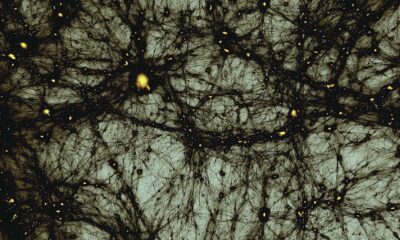Science
Research Uncovers Potential Fifth Dimension to Explain Dark Matter

Recent scientific inquiries suggest that the elusive mystery of dark matter might be rooted in a hidden fifth dimension, rather than in particles dispersed throughout the universe. Researchers have been exploring various cosmic phenomena, including supernovas, to better understand this phenomenon. A study published in 2024 in Wired introduces a concept known as the “dark dimension scenario,” which posits that alongside the known four dimensions of spacetime—three spatial dimensions and time—there could exist a compact fifth dimension that accounts for the effects attributed to dark matter.
This proposed dimension may harbor heavy particles, such as gravitons, that could function similarly to dark matter. Such particles would contribute the “missing mass” needed to explain why galaxies rotate at the observed speeds and how the universe’s structure develops. SciTechDaily explains that by examining ordinary matter from a five-dimensional viewpoint, scientists might identify new heavy particles that link typical matter with the hidden realm of dark matter.
Dark matter remains an invisible aspect of the universe, detectable only through its gravitational effects on visible matter, such as stars and galaxies. For instance, stars in a galaxy can be likened to racecars on a track; they move at such high speeds that without an unseen force anchoring them, they would veer off course. This unseen force is analogous to dark matter, providing the necessary gravitational pull to maintain the galaxy’s structure.
The analogy extends further into popular culture, drawing parallels to the Tesseract from the “Avengers” film series. The Tesseract serves as a conduit between realms, much like how scientists envision the hidden fifth dimension functioning as a portal to dark matter. Although researchers have yet to fully comprehend the nature of dark matter, they have theorized that it can be manipulated or even “heated,” suggesting significant implications if the fifth dimension scenario holds true.
If validated, this concept could transform our understanding of the universe. The predictions associated with this scenario indicate the existence of new heavy particles that could act as messengers bridging our known universe and the concealed dimension. Discovering these particles would represent the first tangible evidence of physics beyond the four-dimensional construct we are accustomed to.
To explore these theories, scientists are utilizing advanced experimental setups and tools, including a new observatory aimed at redefining current scientific paradigms. They are actively searching for anomalous signals, such as subtle gravitational effects or transient particles that behave differently than known matter. One such effect is gravitational lensing, where dark matter’s gravity distorts light, revealing essential clues that could confirm the existence of a fifth dimension.
The potential discovery of this hidden realm would not only elucidate the nature of dark matter but also expand the foundational laws of physics. It could reshape our understanding of gravity, the formation of galaxies, and the trajectory of future particle physics experiments. In doing so, it would push the boundaries of scientific exploration, enhancing our comprehension of the cosmos.
-

 Entertainment3 months ago
Entertainment3 months agoAnn Ming Reflects on ITV’s ‘I Fought the Law’ Drama
-

 Entertainment4 months ago
Entertainment4 months agoKate Garraway Sells £2 Million Home Amid Financial Struggles
-

 Health3 months ago
Health3 months agoKatie Price Faces New Health Concerns After Cancer Symptoms Resurface
-

 Entertainment3 months ago
Entertainment3 months agoCoronation Street’s Carl Webster Faces Trouble with New Affairs
-

 Entertainment3 months ago
Entertainment3 months agoWhere is Tinder Swindler Simon Leviev? Latest Updates Revealed
-

 Entertainment4 months ago
Entertainment4 months agoMarkiplier Addresses AI Controversy During Livestream Response
-

 Science1 month ago
Science1 month agoBrian Cox Addresses Claims of Alien Probe in 3I/ATLAS Discovery
-

 Entertainment4 months ago
Entertainment4 months agoKim Cattrall Posts Cryptic Message After HBO’s Sequel Cancellation
-

 Entertainment3 months ago
Entertainment3 months agoOlivia Attwood Opens Up About Fallout with Former Best Friend
-

 Entertainment6 days ago
Entertainment6 days agoCoronation Street Fans React as Todd Faces Heartbreaking Choice
-

 Entertainment3 months ago
Entertainment3 months agoMasterChef Faces Turmoil as Tom Kerridge Withdraws from Hosting Role
-

 Entertainment4 months ago
Entertainment4 months agoSpeculation Surrounds Home and Away as Cast Departures Mount















